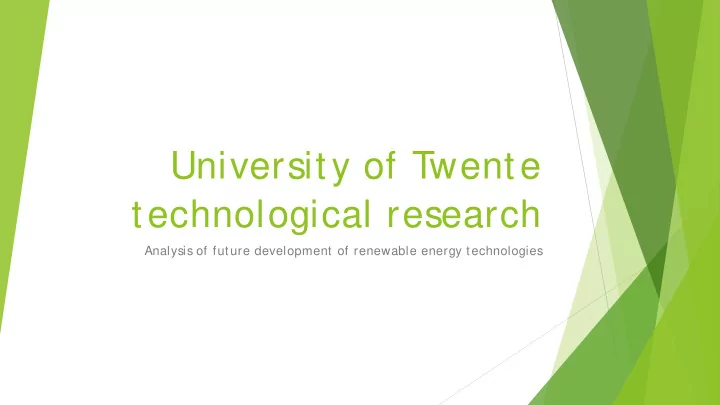

University of Twente technological research Analysis of future development of renewable energy technologies
Research question What are the expectations and perceived vulnerabilities in authorative scenarios and academic literature regarding the development of renewable energy technologies in the period 2020 – 2050?
Authoritive groups International Energy Agency (IEA) Intergovernmental Panel on Climate Change (IPCC) International Renewable Energy Agency (IRENA)
IEA scenarios Current policies, 40% renewables by 2050 2-Degrees, 76% renewables by 2050 New policies, 53% by 2050
Wind Energy Wind will be highest share in renewables Current policies: 16,0% 2-Degrees: 34,4% New policies: 22,6% Current efficiency is ca. 50% , maximum theoretical efficiency is 59%
Wind Turbine size
Solar PV Expected share of PV in Europe is small Current policies: 3,5% 2-Degrees: 7,4% New policies: 4,9% Matured technology, still lot of room for improvement, price per kWh
PV is becoming cheap Costs of silicon PV will decrease 19-36% by 2025 and 40- 72% by 2050. New materials are being developed Organic PV (12% efficiency, $30/ m2) Currently j ust as expensive as offshore wind
Concentrated Solar Power
Bioenergy 2nd generation biofuels will add to an increased share Current policies: 5,8% by 2050 2-Degrees: 9,4% by 2050 New policies: 6,6% by 2050 Not location specific
Hydropower Not expected to develop further in the EU Very specific locations Current policies: 12,9% by 2050 2-Degrees: 18% by 2050 New policies: 15,2% by 2050 Improved life-cycle of components
Geothermal Uses earth’s interior heat by drilling and heating water Current policies: 0,57% by 2050 2-Degrees: 1,64% by 2050 New policies: 0,9% by 2050 No significant changes in costs expected
Ocean Energy Will not play a significant role in the energy transition until at least 2030 Not yet commercialized Hardly any literature on this subj ect available
Energy efficiency Converting energy Energy loss in chain High Temperature S uperconductors (HTS ) can increase efficiency to 99.9% Predictions very dependent on innovations in technologies
Energy storage Very important for energy transition S hare of renewables can increase only with energy storage technologies. Pumped Hydro S torage is currently largest share of storage (99% ) Battery systems are promising S torage facilitates effective use of energy produced by renewable sources
Risks and uncertainties Future is uncertain Focus on production, while storage is necessary Full dependence on technology instead of politics Neglected infrastructure
Recommend
More recommend